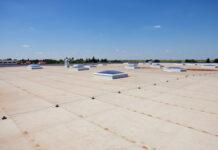This article addressing facility maintenance strategies is contributed by C&W Services, a facility services company with a 65-year history. Formed by the merger of Cushman & Wakefield and DTZ, C&W Services is the only firm in commercial real estate to self-deliver facility services, and these include janitorial, maintenance, critical environments, landscaping, and office services.
Real estate departments have long been under pressure to contribute to the bottom line through cost savings. As companies continue to trim their budgets, so continues scrutiny of facilities operations dollars, particularly for maintenance.
With this pressure comes the need to make the decision: As an owner, should you spend money now to perform proactive maintenance? Or is it less expensive to run systems longer, and possibly to failure, to reduce current labor and material expenses? The inflection point of any proactive facility maintenance decision is not only the cost, but when to incur it. Pay now, or pay later?
To start, we need to define the burning “why” of a proactive maintenance program. In the United States alone, an estimated $800 million a year is spent on facility or plant maintenance. Performing proactive maintenance is estimated to save 40% to 60% on operational and reactive costs. Taking a very conservative estimate of the bottom half of that range, a 20% savings in maintenance costs yields $160 million a year, which could go a long way to tackling immediate and deferred capital needs. Applying that math to a property portfolio with a $2 million annual spend on facility maintenance yields $400,000 in annual savings — a significant contribution to corporate cost-saving initiatives.
To help our clients define the return on proactive maintenance investment, C&W Services takes that simple equation further. First, we define maintenance as the activities required or undertaken to conserve as nearly, and for as long as possible, the original condition of an asset while compensating for normal wear and tear, whether proactive or reactive.
Decisions that seem straightforward are more complex when you take into account maintenance and lifecycle options. For example, a low cost roof that needs regular inspection and maintenance might be a cost-effective option for a property with a short- term ownership horizon. But an owner anticipating a 30-year property lifespan may select a more expensive but maintenance free roof having a lower total cost in the long run.
While the target of programs such as Reliability Centered Maintenance (RCM) or Business Focused Maintenance (BFM) is to execute proactive maintenance activities as 75% to 85% of efforts, we find the reverse is mainly true. The reality of most clients’ staffing and budget drive them to operate with more than half of their efforts as reactive.
In determining the right balance for a portfolio, the goal is to find the proper ratio of activities against available resources for facilities maintenance. The target should be based on what you perform the proactive activities on as defined by your financial model. To counter the norm, move from the more traditional model to target goals in alignment with RCM principles shown above.
For many companies, the transformation to a more effective model can’t start without better insight into the current state. So how do you answer the question of where you are today? We help clients by reviewing work order data, analyzing the labor and materials being expended toward proactive and reactive maintenance. Forecasted renewal and replacement projects are considered as well. From that data we begin to build a more accurate picture of the types of maintenance being performed, and the cost per square foot for planned and unplanned projects. This is the foundation of predicting how to maximize annual maintenance and repair costs in a more proactive model. However, an additional data set is needed.
Studies performed by C&W Services across numerous organizations show a common gap in accurate asset inventories. Since you can’t maintain “it” if you haven’t defined “it,” an asset inventory is the second critical element of a more effective proactive maintenance effort.
First identify what is under warranty and the code “shalls,” as these are the only items that require preventive maintenance. Once an asset is out of warranty, maintenance truly becomes optional. As provocative as the thought of optional maintenance is, with the principles above, we can help determine the criticality of the equipment. Understanding all building assets and their value to the work performed in the building helps determine what kind of maintenance to perform and when — and begins to answer the “pay now or pay later” question. In quantifying the value of an asset, and thus the return on investment in its maintenance, real estate professionals can consider:
- The current actual cost of preventive maintenance or predictive maintenance activities
- What it will cost, or currently costs, to repair the equipment from unpredicted failures or corrective maintenance identified during the PvM activities during the warranty period
- The cost to replace the equipment (material and labor)
- Expected or known life cycle of the equipment
- And last but not least, cost of downtime.
As the engineer, statistician, and management guru W. Edwards Deming said, “In God we trust; all others bring data.” Knowing the full picture of maintenance options and costs will allow you to determine the return on preventive maintenance vs. a run to fail model. Although the process sounds complicated, it really isn’t. It just takes a commitment to understanding what you have, the costs to do PM, and the costs of running to fail. For the staff operating facilities and managing real estate decisions, being armed with complete data helps build the case for the right investment — at the right time — to align with long-term business strategies.
Pay now, or pay later? What is your current approach to equipment and building maintenance? Do this approach work well, or are you looking to improve your maintenance planning? Please share your thoughts, experiences, and comments below.




















![[VIDEO] Collect Asset Data at the Speed of Walking a Building](https://facilityexecutive.com/wp-content/uploads/2024/02/maxresdefault-324x160.jpg)